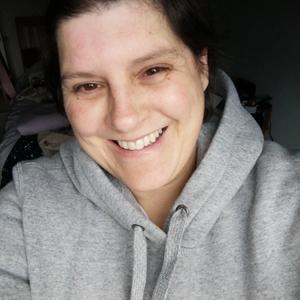The Know AML website uses a third-party service provided by Google that dynamically translates web content. Translations are machine generated, so may not be an exact or complete translation, and Know AML cannot guarantee the accuracy of translated content. Know AML and its employees will not be liable for any direct, indirect, or consequential damages (even if foreseeable) resulting from use of the Google Translate feature. For further support with Google Translate, visit Google Translate Help. The interviews webpage also uses YouTube, where subtitles and translations are generated automatically by AI; please be advised to exercise caution when precise interpretation is required. For further support with YouTube, visit YouTube Help.

Gillian's story
Patient
February 1, 2022
“I’m not going to mince my words, you have leukemia” – wasn’t what I was expecting to hear when I got my test results back. I was diagnosed with leukemia in June 2018, after about a year of feeling up and down. I was a fit and healthy PE teacher who was used to being on the go 24/7; however, I had been getting frequent ear, throat, and chest infections and after a few months, I just felt like I couldn’t get enough sleep, I was constantly feeling wiped out and drained. On reflection, I probably had a few more aches and pains than normal but with an active job, I always put it down to something else.
After continually getting blood work done, I was referred to an oncologist to see what was going on as my blood levels were a bit off. They thought I had neutropenia but in the process of testing, I took sepsis in my knee. Spending weeks in hospital, my bloods weren’t picking up and it was suggested we do a bone marrow biopsy to see where the neutropenia was happening, either inside/outside my white blood cells. Never did I expect to be told I had leukemia.
After diagnosis, I was quickly meeting with specialists who told me that I had acute myeloid leukemia, and they explained what it was.
In a space of a few weeks, I had gone from worrying about lesson plans and marking, to starting to focus on my key numbers, like neutrophil and platelet levels. I was surrounded by strangers who became friends in my hospital ward, and staff who were amazing. From the start, it was clear I was going to need a transplant so the search for a match was on.
My treatment included two cycles of chemotherapy that comprised of two programs each time whilst being part of a treatment trial, and the times in between eating goji berries and dark chocolate to get the neutrophil numbers up—it was a ‘ward fact’ that they helped. Each process was explained to me and I was lucky that two possible 100% matches were found using the worldwide registers, which meant I didn’t need the third cycle. I was allowed a few precious days at home in between finishing my second cycle and starting the preparation for my transplant, which involved 3 days of intense chemotherapy and then 4 days of double whole body radiotherapy sessions. This was the most mentally taxing bit of all my treatment; by the last one, I felt like even blinking took a monumental effort. However, the day after this, I received my transplant from someone who was a stranger, but I am now in contact with. Then, 25 days later, I was allowed to go home to start my recovery and my 100-day isolation. During this time, the effects of the medications kicked in and I could barely go anywhere without ‘Barry the basin’ by my side (sorry to any Barrys reading this), but as time went on, I could walk one lamppost further than I did the last time.
Now, 3 years on, I am still getting used to living a new normal life and making the adjustments I have had to, but each day gets better. I still have days where doing the simplest of things takes a great effort, but it is a small price to pay for the time I am getting to spend with family and friends, which I was unsure if I would have. I have made lifelong friends with people I would never have met if I hadn’t got ill, and I am living by the mantra I used throughout treatment—that being positive was the only option for me.
What did you think of this patient story? Let us know at ses_knowaml@scientificeducationsupport.com